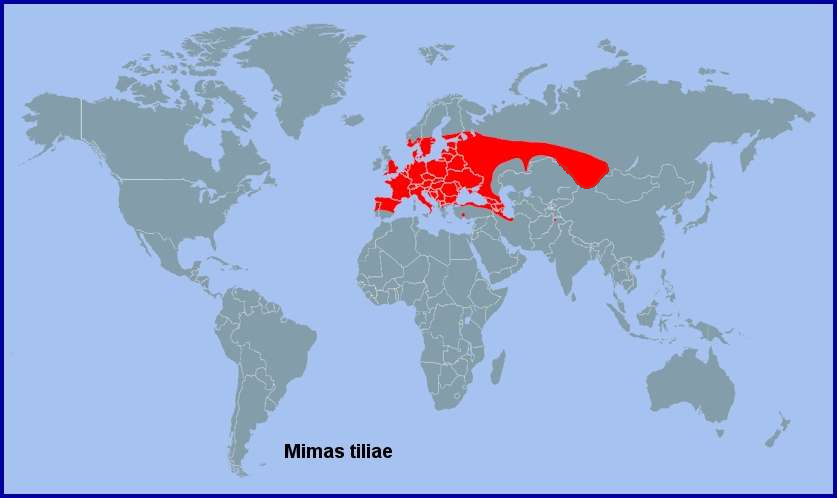UK: Lime Hawkmoth; Linden Hawkmoth, F: Sphinx du Tilleul, D: Lindenschwärmer, RUS: Lipovyi Brazhnik, S: Lind-Nattsvärmare; Lindsvärmare, NL: Lindepijlstaart, CZ: Lišaj lípový, H: hársfaszender, E: esfinge del tilo, PL: Zmrocznik lipowiec; Nastrosz lipowiec, FIN: Lehmuskiitäjä, I: sfinge del tiglio, HR: lipin ljiljak, DK: Lindesværmer, N: Lindesvermer, EST: Pärnasuru.
Mimas kitchingi Melichar & Řezáč, 2015, European Entomologist 6(4): 205.Type locality: Čalús [Pass], 80km N. Tehran, Iran, 2270m.
(Taxonomic note. (i) The semi-isolated population from the Alborz mountains of northern Iran was described as a separate species in 2015, namely Mimas kitchingi Melichar & Řezáč, 2015. With adult appearance and male genitalia differing little from the nominate race, this was established solely on a 2.73% difference in a DNA barcode sequence between one individual from both the European and Alborz populations. With no indication given as to the natural variation in DNA barcode sequences in the nominate population of Europe [the largest difference in BOLD, between two specimens of Mimas tiliae tiliae from the UK and Turkey, is about 2.96% (Ian Kitching, pers. comm. 2015)], the elevation of the Iranian population to species level is somewhat premature. Given that natural variation within clearly defined taxa of the Smerinthini can vary up to 3% or more, a variation of 3.5-4% is required before a population can be considered a new species. A difference of 3% or less indicates either a new subspecies or just natural variation within a given population. Only traditional hybridization experiments between the two populations will settle this issue, as they have done for Laothoe austauti (Staudinger, 1877) and Laothoe populi populi (Linnaeus, 1758).)
Holarctic; western Palaearctic region. Pleistocene refuge: Monocentric -- Syrian refuge.
![Male Mimas tiliae kitchingi, Čalús Pass, 80km N. Tehran, Iran, 2270m [HOLOTYPE]. Photo: © SMCR. Male Mimas tiliae kitchingi, Čalús Pass, 80km N. Tehran, Iran, 2270m [HOLOTYPE]. Photo: © SMCR.](m_kit_a1.jpg)
Wingspan: 60--80mm. The descriptions (and illustrations) given by Melichar & Řezáč, 2015, of both adults and male genitalia, fall well within the normal range of Mimas tiliae tiliae (Linnaeus, 1758).
Montane deciduous woodland between 200m and 2270m (Melichar & Řezáč, 2015). Confined to the upper and northern slopes of the Alborz mountains.
Probably bivoltine, as adults have been captured in April and June/July (Melichar & Řezáč, 2015).
Unknown.
Hostplants. Unknown.
Unknown.
Confined to the montane deciduous forests of the Alborz mountains, northern Iran (Sutton, 1963; Lehmann & Zahiri, 2011; Melichar & Řezáč, 2015; Emad Tahaei, iNaturalist 2023), southeastern Azerbaijan (Talysh (Effendi, 1967); Hirkan Park (iNaturalist 2009)) and, maybe, northern Pakistan (see below).
In 2009 a male was captured in northern Pakistan (Great Karakorum Mountains, west of Chikar, 4000–4500m, viii.2009 (leg. V. Gurko, coll. Sphingidae museum of Czech Rep.)). This could have been the result of an 'import' of a pupa or adult from Europe, or a representative of an isolated, relict population. However, as Humairah Hanif et al. (2016) records a further 16 individuals from Chakwal Punjab, this species must be resident. DNA barcode sequence analysis has since confirmed that this population is allied to Mimas tiliae kitchingi Melichar & Řezáč, 2015 from northern Iran.
Extra-limital range. None.

Across central and southern Europe (including northern Iberia and Sicily), northern and central Greece, northern and western Turkey to the Republic of Georgia, Daghestan, northern Azerbaijan and western Siberia, Russia, as Mimas tiliae tiliae (Linnaeus, 1758). Mimas christophi (Staudinger, 1887) from eastern Russia (Derzhavets, 1984), Japan, northern China (Chu & Wang, 1980b) and Korea (Kim, Nam & Lee, 1982), is a distinct species.
 Return to species list
Return to species list